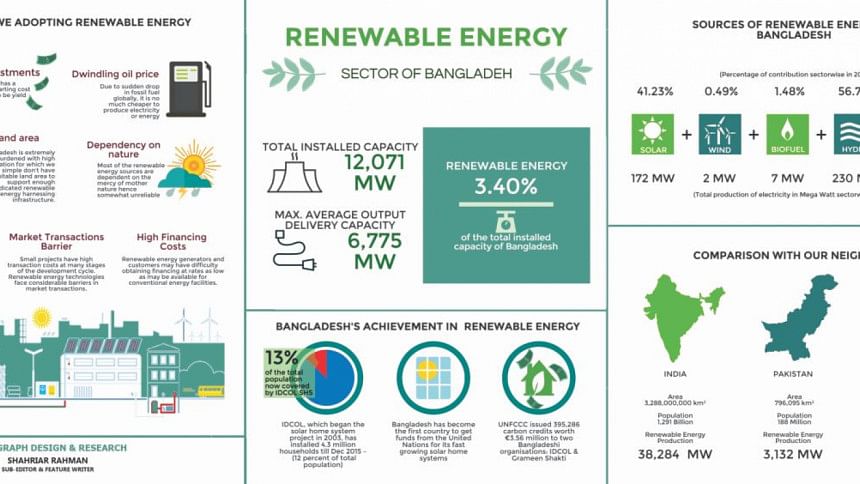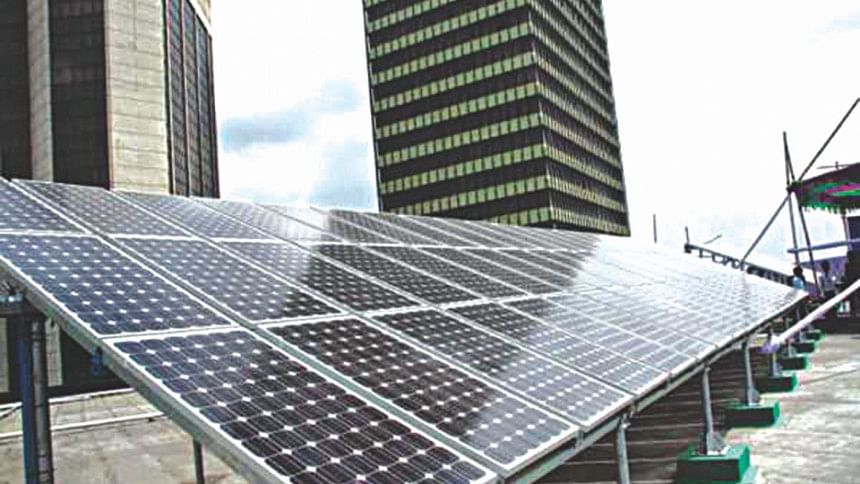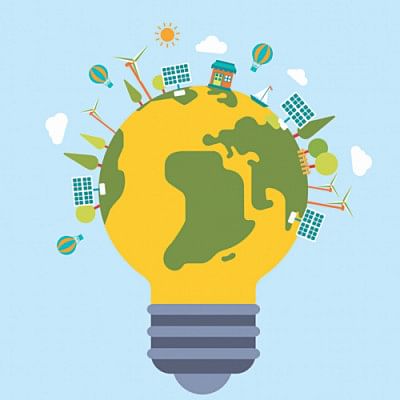Feed-in-Tarrif (FITs): Rays of hope for renewable green energy

Bangladesh has been experiencing a huge gap between supply and demand of electricity; 40% of the population still do not have access to electricity. The majority of rural population have been relying on biomass fuel broadly. Electricity is the key to economic growth and development. Bangladesh is an energy starved country with only 321KWH/capita/year electricity use. The per capita energy use of us is much lower compared to neighbouring India and that of Pakistan as well.
Bangladesh has been making significant progress within the promotion of its electricity generation in recent years comparing to the recent past. There has been a paradigm shift, from a traditional centralised approach of electricity generation towards a public private sector energy development through where Independent Power Producers (IPP) has been playing the key role. The mechanism has resulted into a generation of almost 4700 MW of electricity. Likewise, the country has made an essential basis for the advancement of renewable energy fitting to the development where the main means of power has been biomass. The good news is this – efforts of renewable development to electrify rural homes through multilateral development funding has resulted into development of 135 MW energy from solar power alone. Since energy is the real currency for development we are in a serious need to develop our electricity and other form of commercial energy. As of September 2015, Bangladesh Power Development Board (BPDP) has managed to supply 11,088 MW of Electricity including its imported 500MW.


The government has a commitment to develop 5% share of energy through development of renewable energy sources by this year; and 10% by 2020. Solar energy development has been a great success story in rural development. However, the challenge is to reach up to the target of renewable on the mentioned time frame. In order to reach the target, there is a need of development programmes in cities where development of solar energy needs a big push from government, financial institutions, donor aided funding. The policy tool feed-in-tariff (FITs) is yet to come into force although the draft document has been done so far. Since it was supposed to come into force this June hope still remains that we will see the gazette notification soon.
Feed-in-tariff (FITs) has been a proven policy tool to develop renewable energy both in developed and developing countries. FITs is indeed a policy mechanism, which is specifically designed to accelerate investment in renewable energy technologies by providing them a fee or tariff above the retail rate of electricity. It helps to encourage the use of new renewable energy technologies often from low carbon sources: such as wind power, biomass, hydro-power, geothermal power, tidal power and solar photo voltaic. Also, highlighting that technology such as wind power, for instance, are awarded a lower KHW price, while solar and tidal power are offered a higher price. Thus FIT helps by offering a higher price rather than paying equal amount in market rate. Reflecting the cost higher at the moment. It also provides an offer for long term contracts to green renewable energy producers typically based on the cost of each technology. The contract for majority of sources is usually 20 years, while for solar, it is 25 years. Therefore, the goal of FITs to allow reasonable tariff for different sources of green renewable at different levels of operations. Although generally speaking without considering sustainability for economy and environment these sources are costlier than that of the traditional carbon based or other risky nuclear sources; nonetheless this green technology builds up economy increasing small entrepreneurs and employment, increasing electricity, helps environment and helps to offset carbon thus helps in climate change challenges mitigation.

Thailand has approved its FITs in 2006; while India in 2010, Uganda in 2011, China in 2011, Indonesia in 2012, The Philippines in 2012 (got approved in 2008 but implemented in 2012). They want fixed FITs regime for solar in India; otherwise solar project would lose its viability. Although having FITs in place, India has an auction system. India has reached a significant way forward (3000 MW) but still banking sector want reform in FITs by introducing fixed FITs regime with a 25-year contract. The Indian Prime minister also suggested a move from an auction based to a fixed FITs in recent years. The global experiences have suggested that 70% of the renewable projects have been sustainable. Fixed FITs therefore, helped countries of Europe and North America to accelerate the investment in renewable. Germany for example, almost reached 30% share from renewable is a landmark. Majority of these country put solar tariff 20 cent US or above in FITs. It is worth mentioning that Germany, through its innovative approach has seen successful growth of renewable, from 6% in 2000 to 30% in 2014; the global leader in developing renewable has turned itself into the first major renewable economy where wind power comprises 9.7%, Solar 6.2%, Biomass 10% and hydro 3.5%. In addition, large number of people have been employed in this sector. Briefly speaking in Germany, 1.5 million PV systems have been installed so far ranging from solar rooftop to solar park. Germany as of June 2015, generated 38,850 MW electricity from Solar alone which is ahead of China, Japan, Italy and U.S.A. Growth of Solar and other renewable in India is notably high. They have added 4089 MW in 2014-15 more than its targeted growth.
In Bangladesh there is a limited chance to boost renewable energy other than solar at the moment. Hydro has got some prospect for 5-10 MW small projects identified; while Sangu 140 MW and Matamuhari 75 MW having potential respectively. Biogas has some limited prospect. Prospect of Wind energy and its growth still depending upon the hard data which is expected to come out briefly; while only operational wind turbines are in Feni and Kutubdia. Therefore, government commitment of the targeted growth for renewable will be largely be based on solar energy. The possible avenues been targeted such as off grid home systems in rural Bangladesh (successfully being implemented with IDCOl). Solar Irrigation largest
growth area since half a million pumps targeted to be brought under solar PV generation. Another growth area in solar will be small and medium solar parks, solar street lighting and introducing rooftops solar PV in cities in-grid system that will help the entrepreneur to relief themselves from load shedding and help in adding and reduce dependency respectively on national grid in some scales. Moreover, it will help to add good amount of electricity supply on grid through FITs if policy allows that. Solar parks might be successful even with a permanent 25-year contract. In reality, there is a huge need to accommodate them since lots of small and medium solvent home owners, real state owner smay come up. Hence proper compensation packages for development of rooftop solar PV in cities need to develop in line with FITs, Irrigation (solar pumping) project and small scale government and private solar power parks 1 to 5 MW with 25 years contractual agreement will help in reaching 10% of targeted renewable in Bangladesh. Similarly, medium scale solar parks might be also useful for the growth of renewable. The next paragraph will explain the basic mechanisms of FITs.
Installing an electricity-generating technology from a renewable or low-carbon source such as solar PV or wind turbine, Government's Feed-in Tariffs scheme (FITs) in countries (adopted FITs) could mean that you get money from your energy supplier. You can be paid for the electricity you generate, even if you use it yourself, and for any surplus electricity you export to the grid. And of course you will also save money on your electricity bill, because you will be using your own electricity. In Europe, for example, in the UK the energy market is open and retail being managed by couple of private companies while the infrastructure and legal controls maintained by government. The UK Government's Department for Energy and Climate Change (DECC) makes the key decisions on FITs in terms of government policy. The energy regulator Ofgem administers the scheme. Feed-in Tariff grants as the main financial incentive to encourage uptake of renewable electricity-generating technologies. Most domestic technologies qualify for the scheme, including: solar electricity (PV) (roof mounted or standalone), wind turbines (building mounted or free standing,) hydroelectricity, digester, micro combined heat and power (CHP). In many countries of Europe and Asia solar rooftops has been the potential growth area followed by solar parks. Bangladesh through it's rural rooftops systems has been a proof of that but the potential growth area in rooftops of cities are yet to be initiated by proper FITs. In Bangladesh energy supplier (basically Government Departments) will make the FITs payments to you once it is approved. Eligibility to receive FITs benefit in three ways are given for highly potential rooftops in cities.
Generation tariff
Your energy supplier will pay you a set rate for each unit (or kWh) of electricity you generate. Once your system has been registered, the tariff levels are guaranteed for the period of the tariff (up to 20 years or 25 years) and are index-linked.
Export tariff
Your energy supplier will pay you a further rate for each unit you export back to the electricity grid, so you can sell any electricity you generate but don't use yourself. At some stage smart meters will be installed to measure what you export, but until then it is estimated as being 50 percent of the electricity you generate (only systems above 30 KWP need to have an export meter fitted, and a domestic system is unlikely to be that big).
Energy bill savings
You will be making savings on your electricity bills because generating electricity to power your appliances means you don't have to buy as much electricity from your energy supplier. The amount you save will vary depending how much of the electricity you use on site.
Once you are receiving FITs payments, the rate you get will increase in line with inflation in accordance with the Retail Price Index (RPI). However, there are similarities and differences in FITs rules across the countries.
As soon as FITs comes in Bangladesh there will be a good growth in roof mounted solar in-grid system. It has been successful with FITs in Europe, North America and Asia. In Europe for example, the production capacity of electricity from solar power is almost half compared to Bangladesh because of solar radiation. However, the growth of solar roof mounted in grid system has been very attractive and successful in Europe. In Bangladesh, with FITs, a 4K system (16 PV panels each with 250 WP and inverter) will be ideal in cities. The cost of a 4K system at the moment in Bangladesh is around 8-9 Lakh Taka if they are made in European countries with EU standards. In the UK, 4K system has been standard for a middle class family which costs at about 7-8 K Pounds. The pay back periods for such a system with FITs should be around 8-9 years both in the UK and Bangladesh, although production capacity and tariff structure is different. The economic benefit with for an entrepreneur is the following.
Generation
In Dhaka 1 K solar system will produce 1600-1700 KWH/year electricity in general if they are quality products. Let assume a 4K system will produce 6,400 KWH/Year (lower value taken). However, the production will be reducing every year. If we take the value as per drafted FITs which is 14.72 TK. Then it allows an amount of around 94,000TK alone.
Let us assume half the amount of the electricity produced will be used by the entrepreneur while other half will be exported to the grid. Meaning that helps in reducing dependency on our national grid; moreover it helps in adding an amount into the national grid, well now calculating the value of export of 3200 KWH at rate off 5.4 2TK and use of rest of 3200 KWh at a similar rate. The revenue comes from generation, export and saving electricity is around 126,000 TK. at the first year of operation. Therefore, with even subsequent reduction of production the payback period will not be more than 8 to 9 years. Let us take the example of the UK. 1K solar system will produce 850 KWH/year almost half compared to Bangladesh. However, the payback period for a 4K system will be similar since FITs offers very lucrative fees for solar energy generation for small enterprises in the UK. The per KWH rate is much higher in the UK, as well. Therefore, in current FITs regime of 20 years in the UK an entrepreneur will be enjoying doubling it's investment in the UK for a 4 K system. It will be similar with less incentive in Bangladesh since the production of electricity will be twice for the good quality of sunshine available almost throughout the year. The country's policy makers need to shop around for the funding support from the globe to accommodate renewable energy for green way of energy development, employment and economic and sustainable growth.
The writer is an environmentalist and a non-resident Bangladeshi living in the UK.

 For all latest news, follow The Daily Star's Google News channel.
For all latest news, follow The Daily Star's Google News channel. 



Comments